八年级上册英语语法知识点
- 格式:docx
- 大小:20.50 KB
- 文档页数:9
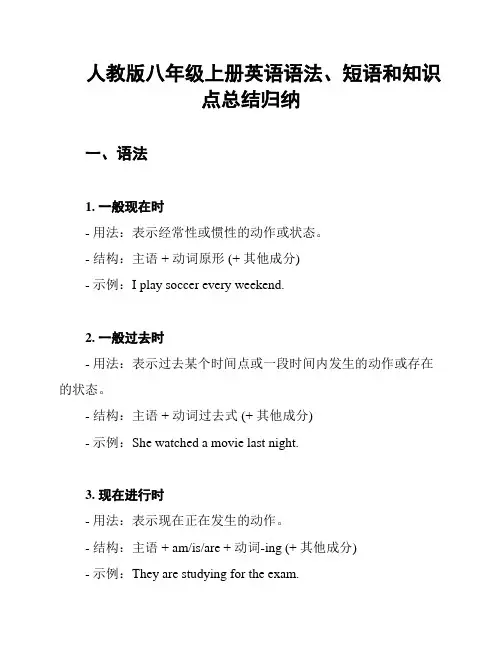
人教版八年级上册英语语法、短语和知识点总结归纳一、语法1. 一般现在时- 用法:表示经常性或惯性的动作或状态。
- 结构:主语 + 动词原形 (+ 其他成分)- 示例:I play soccer every weekend.2. 一般过去时- 用法:表示过去某个时间点或一段时间内发生的动作或存在的状态。
- 结构:主语 + 动词过去式 (+ 其他成分)- 示例:She watched a movie last night.3. 现在进行时- 用法:表示现在正在发生的动作。
- 结构:主语 + am/is/are + 动词-ing (+ 其他成分)- 示例:They are studying for the exam.4. 现在完成时- 用法:表示动作或状态发生在过去某个时间点,但与现在有关。
- 结构:主语 + have/has + 动词过去分词 (+ 其他成分)- 示例:I have finished my homework.5. 情态动词- 用法:表示能力、意愿、可能性等。
- 常见的情态动词有 can, could, may, might, must, should, ought to 等。
- 示例:He should go to bed early.二、短语1. as well as- 用法:表示两个事物同时存在或发生。
- 示例:She can speak English as well as Chinese.2. in order to- 用法:为了做某事。
- 示例:They woke up early in order to catch the train.3. by the way- 用法:用于引入一个新的话题或问题。
- 示例:By the way, have you seen the latest movie?三、知识点1. 直接引语和间接引语- 直接引语:用引号括起来的原话。
- 间接引语:将直接引语转述为陈述句或疑问句。
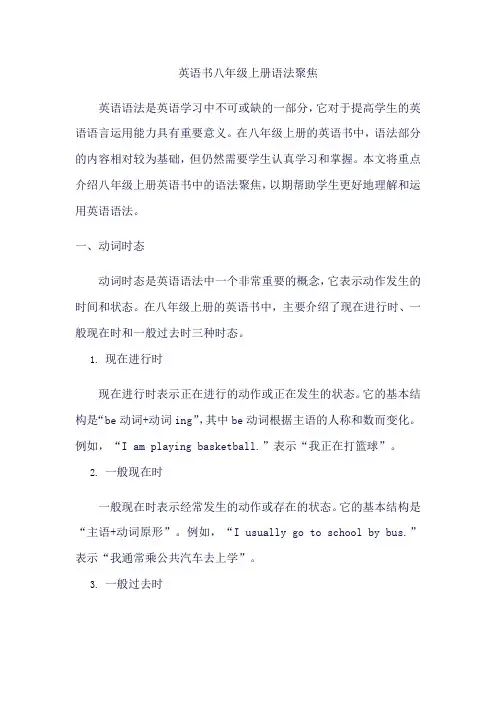
英语书八年级上册语法聚焦英语语法是英语学习中不可或缺的一部分,它对于提高学生的英语语言运用能力具有重要意义。
在八年级上册的英语书中,语法部分的内容相对较为基础,但仍然需要学生认真学习和掌握。
本文将重点介绍八年级上册英语书中的语法聚焦,以期帮助学生更好地理解和运用英语语法。
一、动词时态动词时态是英语语法中一个非常重要的概念,它表示动作发生的时间和状态。
在八年级上册的英语书中,主要介绍了现在进行时、一般现在时和一般过去时三种时态。
1.现在进行时现在进行时表示正在进行的动作或正在发生的状态。
它的基本结构是“be动词+动词ing”,其中be动词根据主语的人称和数而变化。
例如,“I am playing basketball.”表示“我正在打篮球”。
2.一般现在时一般现在时表示经常发生的动作或存在的状态。
它的基本结构是“主语+动词原形”。
例如,“I usually go to school by bus.”表示“我通常乘公共汽车去上学”。
3.一般过去时一般过去时表示过去发生的动作或存在的状态。
它的基本结构是“主语+动词过去式”。
例如,“I saw a movie last night.”表示“我昨晚看了一部电影”。
二、形容词和副词的比较级和最高级形容词和副词的比较级是用来比较两个事物之间的差异,最高级则是用来表示三者或三者以上事物中的最高程度。
在八年级上册的英语书中,主要介绍了形容词和副词的比较级和最高级的构成规则和用法。
1.形容词的比较级是借助形容词后缀“-er”构成的,最高级是借助形容词后缀“-est”构成的。
例如,“happy”的比较级是“happier”,最高级是“happiest”。
2.副词的比较级是借助副词后缀“-er”构成的,最高级是借助副词后缀“-est”构成的。
例如,“fast”的比较级是“faster”,最高级是“fastest”。
三、情态动词情态动词是一种表达个人意愿、推测或判断的动词,它不能单独作谓语,需要跟动词原形一起构成谓语。
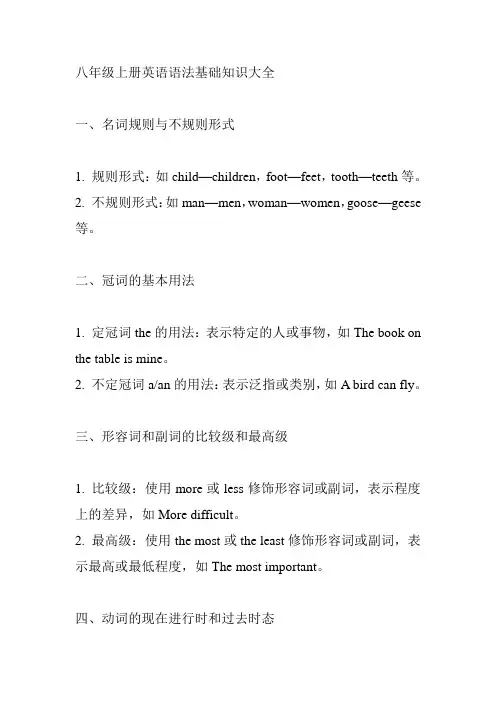
八年级上册英语语法基础知识大全一、名词规则与不规则形式1. 规则形式:如child—children,foot—feet,tooth—teeth等。
2. 不规则形式:如man—men,woman—women,goose—geese 等。
二、冠词的基本用法1. 定冠词the的用法:表示特定的人或事物,如The book on the table is mine。
2. 不定冠词a/an的用法:表示泛指或类别,如A bird can fly。
三、形容词和副词的比较级和最高级1. 比较级:使用more或less修饰形容词或副词,表示程度上的差异,如More difficult。
2. 最高级:使用the most或the least修饰形容词或副词,表示最高或最低程度,如The most important。
四、动词的现在进行时和过去时态1. 现在进行时态:表示正在进行的动作或状态,结构为be + -ing形式,如I am studying。
2. 过去时态:表示过去的动作或状态,结构为动词的过去式,如I studied。
五、被动语态的使用1. 被动语态表示主语是动作的接受者,常用by引导的行为主体,如She was seen by him。
2. 被动语态的构成:be + 过去分词,如The book was written by him。
六、条件状语从句和时间状语从句1. 条件状语从句:表示假设条件,常用if或unless引导,如If you study hard, you will succeed。
2. 时间状语从句:表示时间上的先后关系,常用when、while、as等引导,如When he comes, I will tell him the news。
七、并列句和复合句的结构1. 并列句:由并列连词and、or等连接的句子,结构相对简单,如I like apples and she likes bananas。
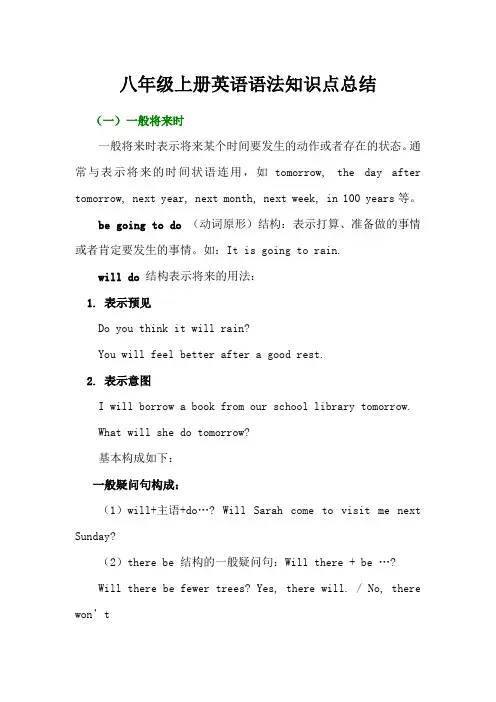
八年级上册英语语法知识点总结(一)一般将来时一般将来时表示将来某个时间要发生的动作或者存在的状态。
通常与表示将来的时间状语连用,如tomorrow, the day after tomorrow, next year, next month, next week, in 100 years等。
be going to do(动词原形)结构:表示打算、准备做的事情或者肯定要发生的事情。
如:It is going to rain.will do结构表示将来的用法:1. 表示预见Do you think it will rain?You will feel better after a good rest.2. 表示意图I will borrow a book from our school library tomorrow. What will she do tomorrow?基本构成如下:一般疑问句构成:(1)will+主语+do…? Will Sarah come to visit me next Sunday?(2)there be 结构的一般疑问句:Will there + be …?Will there be fewer trees? Yes, there will. / No, there won’t否定句构成:will + not (won’t)+doSarah won’t come to visit me next Sunday.特殊疑问句构成:特殊疑问词+will+主语+…?What will Sarah do next Sunday?练一练根据例句,用will改写下列各句例:I don’t feel well today. (be better tomorrow)I’ll be better tomorrow.1. Gina has six classes today. (have a lot of homework tonight)_____________________________2. I’m tired now. (sleep later)_____________________________3. My parents need a new car. (buy one soon)_____________________________4. We can’t leave right now. (leave a little later)_____________________________5. The weather is awful today. (be better tomorrow)_____________________________答案:1. She’ll have a lot of homework tonight.2. I’ll sleep later.3. They’ll buy one soon.4. We’ll leave a little later.5. Maybe it’ll be better tomorrow.(二)should的用法:should用来提出建议和忠告,后边加动词原形,否定句直接在should后边加not.例如:I think you should eat less junk food.我认为你应该少吃垃圾食品。
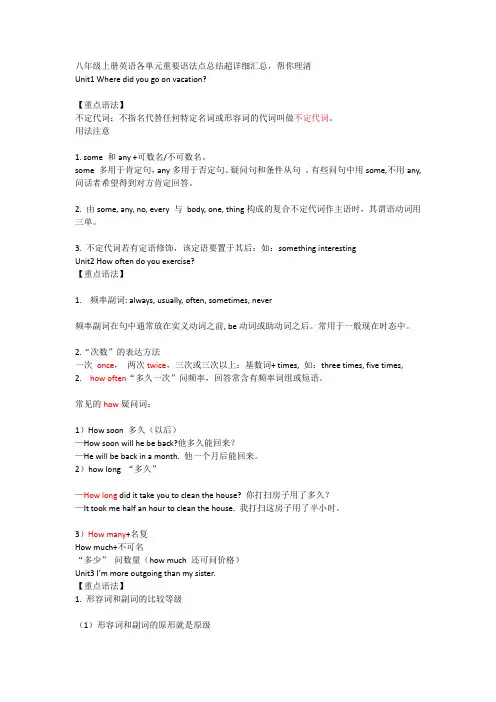
八年级上册英语各单元重要语法点总结超详细汇总,帮你理清Unit1 Where did you go on vacation?【重点语法】不定代词:不指名代替任何特定名词或形容词的代词叫做不定代词。
用法注意1. some 和any +可数名/不可数名。
some 多用于肯定句,any多用于否定句、疑问句和条件从句。
有些问句中用some,不用any, 问话者希望得到对方肯定回答。
2. 由some, any, no, every 与body, one, thing构成的复合不定代词作主语时,其谓语动词用三单。
3. 不定代词若有定语修饰,该定语要置于其后:如:something interestingUnit2 How often do you exercise?【重点语法】1.频率副词: always, usually, often, sometimes, never频率副词在句中通常放在实义动词之前, be动词或助动词之后。
常用于一般现在时态中。
2.“次数”的表达方法一次once,两次twice,三次或三次以上:基数词+ times, 如:three times, five times,2.how often“多久一次”问频率,回答常含有频率词组或短语。
常见的how疑问词:1)How soon 多久(以后)—How soon will he be back?他多久能回来?—He will be back in a month. 他一个月后能回来。
2)how long “多久”—How long did it take you to clean the house? 你打扫房子用了多久?—It took me half an hour to clean the house. 我打扫这房子用了半小时。
3)How many+名复How much+不可名“多少”问数量(how much 还可问价格)Unit3 I’m more outgoing than my sister.【重点语法】1. 形容词和副词的比较等级(1)形容词和副词的原形就是原级(2)比较级,表示较……或更……(3)最高级,表示最...。
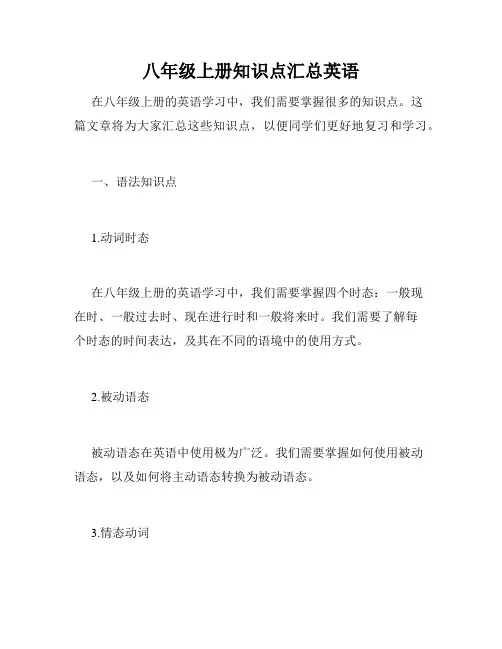
八年级上册知识点汇总英语在八年级上册的英语学习中,我们需要掌握很多的知识点。
这篇文章将为大家汇总这些知识点,以便同学们更好地复习和学习。
一、语法知识点1.动词时态在八年级上册的英语学习中,我们需要掌握四个时态:一般现在时、一般过去时、现在进行时和一般将来时。
我们需要了解每个时态的时间表达,及其在不同的语境中的使用方式。
2.被动语态被动语态在英语中使用极为广泛。
我们需要掌握如何使用被动语态,以及如何将主动语态转换为被动语态。
3.情态动词情态动词是一种特殊的动词形式,包括can、could、may、might、must、shall、should、will和would等。
我们需要了解每个情态动词的意义和用法。
4.虚拟语气虚拟语气用于表达可能的假设、愿望、虚拟的情况、建议等。
我们需要学会使用虚拟语气,并注意不同情况下的使用方式。
二、单词和词组知识点1.常用动词和形容词在八年级上册的英语学习中,我们需要掌握一些常用的动词和形容词。
例如:finish、like、enjoy、happy、sad、angry等。
这些单词经常出现在日常生活中,因此我们需要熟练掌握它们。
2.常用词组熟练掌握一些常用词组对于我们的英语学习是非常有帮助的。
例如:take care of、look forward to、work on、pay attention to等。
这些词组在我们的英语表达中使用频率较高,因此我们需要注意学习它们的用法。
3.其他单词和词组在八年级上册的英语学习中,我们还需要学习一些其他的单词和词组。
例如:transportation、entertainment、wildlife、historic sites、directions等。
这些单词和词组与生活中的各个方面相关,我们需要在学习它们的同时了解它们的实际意义和使用场合。
三、阅读理解知识点1.注意细节在进行阅读理解时,我们需要注意细节。
这包括阅读材料的文字表述、时间和地点等信息,以及与阅读内容相关的语言技能。
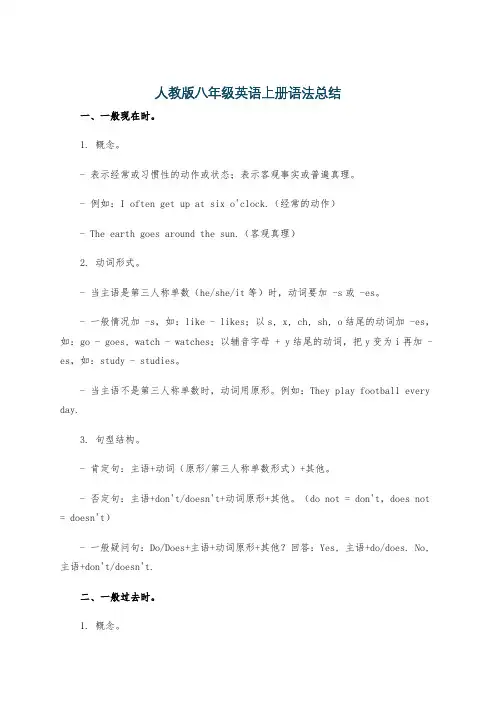
人教版八年级英语上册语法总结一、一般现在时。
1. 概念。
- 表示经常或习惯性的动作或状态;表示客观事实或普遍真理。
- 例如:I often get up at six o'clock.(经常的动作)- The earth goes around the sun.(客观真理)2. 动词形式。
- 当主语是第三人称单数(he/she/it等)时,动词要加 -s或 -es。
- 一般情况加 -s,如:like - likes;以s, x, ch, sh, o结尾的动词加 -es,如:go - goes, watch - watches;以辅音字母 + y结尾的动词,把y变为i再加 -es,如:study - studies。
- 当主语不是第三人称单数时,动词用原形。
例如:They play football every day.3. 句型结构。
- 肯定句:主语+动词(原形/第三人称单数形式)+其他。
- 否定句:主语+don't/doesn't+动词原形+其他。
(do not = don't,does not = doesn't)- 一般疑问句:Do/Does+主语+动词原形+其他?回答:Yes, 主语+do/does. No, 主语+don't/doesn't.二、一般过去时。
1. 概念。
- 表示过去某个时间发生的动作或存在的状态。
- 例如:I went to the park yesterday.2. 动词形式。
- 一般动词在词尾加 -ed,如:play - played;以不发音的e结尾的动词加 -d,如:live - lived;以重读闭音节结尾且末尾只有一个辅音字母的动词,双写这个辅音字母再加 -ed,如:stop - stopped;以“辅音字母 + y”结尾的动词,把y变为i再加 -ed,如:study - studied。
还有一些不规则动词,如:go - went, see - saw等。
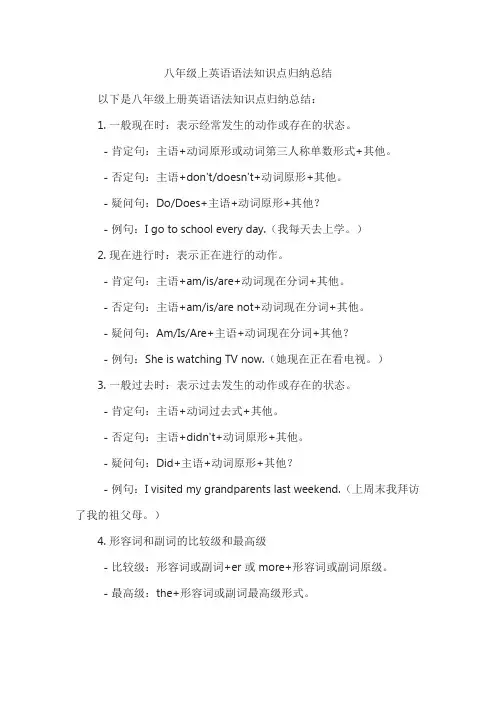
八年级上英语语法知识点归纳总结以下是八年级上册英语语法知识点归纳总结:1. 一般现在时:表示经常发生的动作或存在的状态。
- 肯定句:主语+动词原形或动词第三人称单数形式+其他。
- 否定句:主语+don't/doesn't+动词原形+其他。
- 疑问句:Do/Does+主语+动词原形+其他?- 例句:I go to school every day.(我每天去上学。
)2. 现在进行时:表示正在进行的动作。
- 肯定句:主语+am/is/are+动词现在分词+其他。
- 否定句:主语+am/is/are not+动词现在分词+其他。
- 疑问句:Am/Is/Are+主语+动词现在分词+其他?- 例句:She is watching TV now.(她现在正在看电视。
)3. 一般过去时:表示过去发生的动作或存在的状态。
- 肯定句:主语+动词过去式+其他。
- 否定句:主语+didn't+动词原形+其他。
- 疑问句:Did+主语+动词原形+其他?- 例句:I visited my grandparents last weekend.(上周末我拜访了我的祖父母。
)4. 形容词和副词的比较级和最高级- 比较级:形容词或副词+er 或 more+形容词或副词原级。
- 最高级:the+形容词或副词最高级形式。
- 例句:She is the most beautiful girl in our class.(她是我们班最漂亮的女孩。
)5. 情态动词:表示能力、许可、请求、义务等。
- 肯定句:主语+情态动词+动词原形+其他。
- 否定句:主语+情态动词 not+动词原形+其他。
- 疑问句:情态动词+主语+动词原形+其他?- 例句:You must finish your homework before watching TV.(你必须在看电视之前完成你的家庭作业。
)6. 不定代词:不指明代替任何特定名词或形容词的代词。
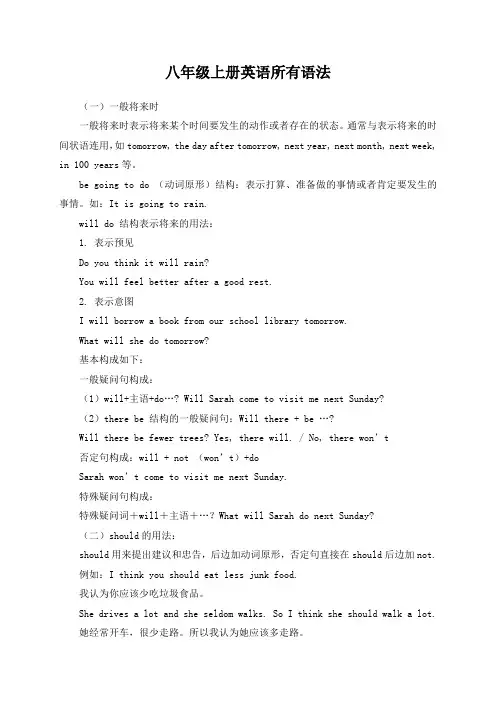
八年级上册英语所有语法(一)一般将来时一般将来时表示将来某个时间要发生的动作或者存在的状态。
通常与表示将来的时间状语连用,如tomorrow, the day after tomorrow, next year, next month, next week, in 100 years等。
be going to do (动词原形)结构:表示打算、准备做的事情或者肯定要发生的事情。
如:It is going to rain.will do 结构表示将来的用法:1. 表示预见Do you think it will rain?You will feel better after a good rest.2. 表示意图I will borrow a book from our school library tomorrow.What will she do tomorrow?基本构成如下:一般疑问句构成:(1)will+主语+do…? Will Sarah come to visit me next Sunday?(2)there be 结构的一般疑问句:Will there + be …?Will there be fewer trees? Yes, there will. / No, there won’t否定句构成:will + not (won’t)+doSarah won’t come to visit me next Sunday.特殊疑问句构成:特殊疑问词+will+主语+…?What will Sarah do next Sunday?(二)should的用法:should用来提出建议和忠告,后边加动词原形,否定句直接在should后边加not.例如:I think you should eat less junk food.我认为你应该少吃垃圾食品。
She drives a lot and she seldom walks. So I think she should walk a lot.她经常开车,很少走路。
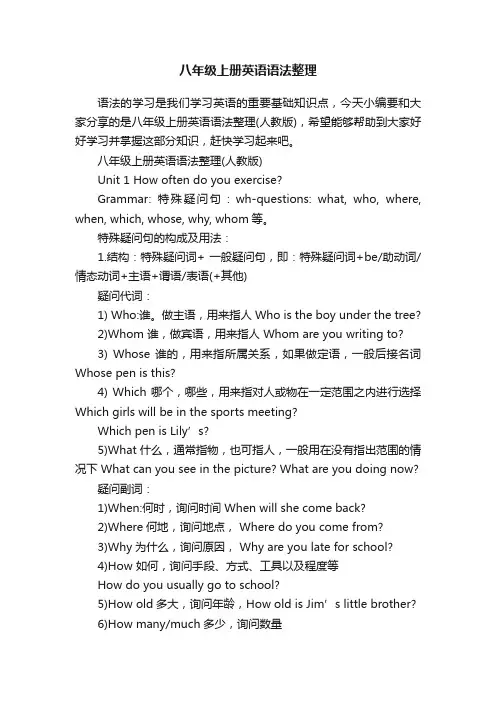
八年级上册英语语法整理语法的学习是我们学习英语的重要基础知识点,今天小编要和大家分享的是八年级上册英语语法整理(人教版),希望能够帮助到大家好好学习并掌握这部分知识,赶快学习起来吧。
八年级上册英语语法整理(人教版)Unit 1 How often do you exercise?Grammar: 特殊疑问句:wh-questions: what, who, where, when, which, whose, why, whom等。
特殊疑问句的构成及用法:1.结构:特殊疑问词+ 一般疑问句,即:特殊疑问词+be/助动词/情态动词+主语+谓语/表语(+其他)疑问代词:1) Who:谁。
做主语,用来指人 Who is the boy under the tree?2)Whom 谁,做宾语,用来指人 Whom are you writing to?3) Whose 谁的,用来指所属关系,如果做定语,一般后接名词Whose pen is this?4) Which 哪个,哪些,用来指对人或物在一定范围之内进行选择Which girls will be in the sports meeting?Which pen is Lily’s?5)What什么,通常指物,也可指人,一般用在没有指出范围的情况下 What can you see in the picture? What are you doing now?疑问副词:1)When:何时,询问时间 When will she come back?2)Where何地,询问地点, Where do you come from?3)Why为什么,询问原因, Why are you late for school?4)How 如何,询问手段、方式、工具以及程度等How do you usually go to school?5)How old多大,询问年龄,How old is Jim’s little brother?6)How many/much多少,询问数量How many birds are there in the tree?7)How far多远,询问距离,How far is it form your home to school?8)How long多长,多久,询问时间的长度或距离How long will you stay in Beijing?9)How often多长时间按一次,询问频率How often do you go to see your grandparents?10How soon多久,询问时间 How soon will you come back?频率副词:表示动作发生的频率,never, hardly ever,sometimes, often, usually, always.Unit 2 What’s the matter with you?Grammar:1. 用have 来描述身体不适 have/have got a +疾病名字;得了……病2.情态动词should,情态动词should,can, may, must没有人称和时态的变化,后接动词原形.Unit 3 What are you doing for vacation?Grammar:现在进行时表将来一般将来时表示将要做某事或计划打算做某事要用到句型“be+doing”其中be是助动词,它有人称和单复数的变化。
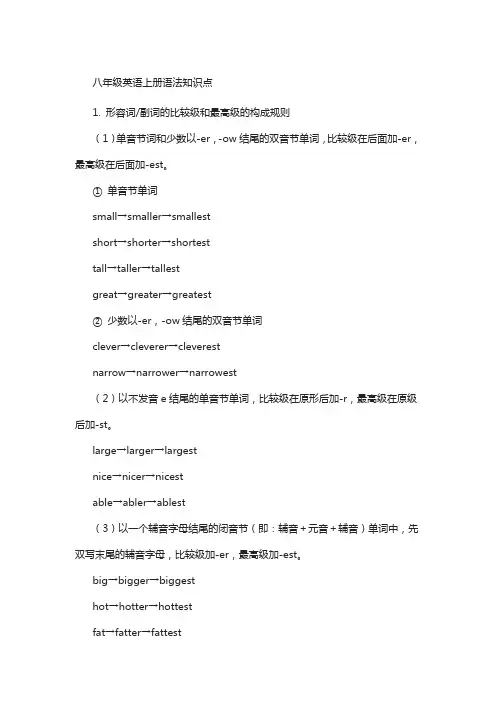
八年级英语上册语法知识点1. 形容词/副词的比较级和最高级的构成规则(1)单音节词和少数以-er,-ow结尾的双音节单词,比较级在后面加-er,最高级在后面加-est。
①单音节单词small→smaller→smallestshort→shorter→shortesttall→taller→tallestgreat→greater→greatest②少数以-er,-ow结尾的双音节单词clever→cleverer→cleverestnarrow→narrower→narrowest(2)以不发音e结尾的单音节单词,比较级在原形后加-r,最高级在原级后加-st。
large→larger→largestnice→nicer→nicestable→abler→ablest(3)以一个辅音字母结尾的闭音节(即:辅音+元音+辅音)单词中,先双写末尾的辅音字母,比较级加-er,最高级加-est。
big→bigger→biggesthot→hotter→hottestfat→fatter→fattest(4)以“辅音字母+y”结尾的双音节词,把y改为i,比较级加-er,最高级加-est。
easy→easier→easiestheavy→heavier→heaviestbusy→busier→busiesthappy→happier→happiest(5)其他双音节词和多音节词,比较级在前面加more,最高级在前面加most。
beautiful→more beautiful→most beautifuldifferent→more different→most differenteasily→more easily→most easily(6)有少数形容词、副词的比较级和最高级是不规则的,必须熟记。
good→better→bestwell→better→bestbad→worse→worstill→worse→worstold→older/elder→oldest/eldestmany/much→more→mostlittle→less→leastfar →further/farther→furthest/farthest2. 形容词和副词比较级的用法(1)“甲+be+(倍数)+形容词比较级+than+乙”表示“甲比乙…”或“甲比乙…几倍”。
八年级上册英语重点语法归纳一、一般过去时。
1. 概念:表示过去某个时间发生的动作或存在的状态。
2. 标志词:yesterday(昨天), last week(上周), last month(上个月), last year(去年), two days ago(两天前), in 1990(在 1990 年)等。
3. 构成:- 主语 + was / were + 其他(主语是第一人称 I 和第三人称单数用 was,其他人称用 were)- 主语 + 动词的过去式 + 其他。
4. 动词过去式的构成规则:- 一般在动词末尾加 -ed,如:play - played。
- 结尾是 e 的动词加 -d,如:like - liked。
- 重读闭音节词,双写末尾辅音字母再加 -ed,如:stop - stopped。
- 以辅音字母 + y 结尾的动词,变 y 为 i 再加 -ed,如:study - studied。
二、频度副词。
1. 常见的频度副词有:always(总是), usually(通常), often(经常), sometimes(有时), seldom(很少), never(从不)2. 频度副词在句中的位置:通常放在实义动词之前,be 动词、助动词或情态动词之后。
三、形容词和副词的比较级和最高级。
1. 比较级的构成规则:- 一般在词尾加 -er。
- 以不发音的 e 结尾的词加 -r。
- 重读闭音节词,双写末尾辅音字母再加 -er。
- 以“辅音字母 + y”结尾的词,变 y 为 i 再加 -er。
- 多音节词和部分双音节词在前面加 more。
2. 最高级的构成规则:- 一般在词尾加 -est。
- 以不发音的 e 结尾的词加 -st。
- 重读闭音节词,双写末尾辅音字母再加 -est。
- 以“辅音字母 + y”结尾的词,变 y 为 i 再加 -est。
- 多音节词和部分双音节词在前面加 most。
3. 比较级和最高级的用法:- 比较级用于两者之间的比较,常用 than 连接。
新人教版八年级上册英语语法,短语和知识点总结一、语法1、时态(1)一般现在时:表示经常性或习惯性的动作或存在的状态,常和表示频度的时间状语连用,如:always, usually, often, sometimes, seldom, never等。
(2)一般过去时:表示过去发生的动作或存在的状态,常和表示过去的时间状语连用,如:yesterday, last week, an hour ago, in 2004等。
(3)现在完成时:表示从过去某一时间一直持续到现在的动作或状态,常和表示过去的时间状语连用,如:since, for, already, yet等。
(4)过去完成时:表示过去某一时间之前已经发生或完成的动作,常和表示过去的时间状语连用,如:before, by the time, when, after等。
2、情态动词(1)can:能够、会(2)could:能够、会(过去式)(3)must:必须(4)have to:不得不、必须(5)should:应该、将要(6)would:将要(过去式)3、虚拟语气(1)一般现在时:主语+should/were to +动词原形+其他(2)一般过去时:主语+should/were to have +过去分词+其他二、短语1、make a difference:有影响,有区别2、at once:立即,马上3、take care of:照顾,照料4、in the end:最后,终于5、be good at:擅长于6、as well as:也,又7、keep healthy:保持健康8、come true:实现,成真三、知识点一般现在时:表示经常性或习惯性的动作或存在的状态,常和表示频度的时间状语连用,如:always, usually, often, sometimes, seldom, never等。
八上语法知识点总结一、词类1. 名词名词是表示人、事物、地点、动作、状态和抽象概念的词。
名词的复数形式、所有格及不可数名词的用法是重要的知识点。
2. 代词代词用来替代名词。
包括人称代词、物主代词、指示代词、不定代词等。
学习代词的正确使用和变化形式是语法学习中的重点。
3. 形容词形容词用来修饰名词,表示人或物的性质、特征或状态。
掌握形容词的用法和比较级、最高级的构成及用法是重要的语法知识点。
4. 副词副词用来修饰动词、形容词和其他副词,表示时间、地点、程度、方式等。
了解副词的分类及其在句子中的位置是必要的知识。
5. 动词动词表示动作或状态。
学习动词的时态、语态、语气、不定式、动名词、分词等是语法学习中的难点。
6. 介词介词通常用来表示时间、地点、方向、原因等概念。
介词短语作状语、定语、宾语等。
7. 连词连词用来连接词与词、短语与短语、句与句。
常见的连词有并列连词、从属连词和关联副词。
二、句子成分句子成分包括主语、谓语、宾语、表语、定语、状语等。
理解各个成分在句子中的作用和位置是语法学习中的重点。
三、时态时态是动词表示的动作或状态所处的时间。
英语有一般现在时、一般过去时、一般将来时、现在进行时、过去进行时、将来进行时、过去完成时、将来完成时等时态。
掌握时态的构成和用法对英语学习至关重要。
四、语态语态包括主动语态和被动语态。
主动语态表示主语是动作的执行者,被动语态表示主语是动作的承受者。
学习语态的变化和用法是语法学习中的难点之一。
五、语气语气包括陈述语气、疑问语气、祈使语气、虚拟语气等。
了解各种语气的构成和用法是语法学习中的重点内容。
以上是八年级上册常见的语法知识点总结,通过系统的学习和实践运用,能够提高自己的语言表达能力,为更高一级的语法学习奠定坚实的基础。
希望同学们能够认真对待语法学习,不断提高自己的语言能力,从而更好地理解和运用英语。
八年级上册英语语法知识点归纳总结1.词类:(1)名词:①普通名词,指人、事物、地点或抽象概念的名称,例如:boy, school, chair等。
②专有名词,指以特定的代号指代某一个固定的个体,例如:Beijing, Li Lei等。
(2)代词:指代替句中的人或物的词,例如:I, you, he, she, it等。
(3)形容词:修饰名词或代词,用来修饰,说明人或物的特征,例如:medium, happy等。
(4)副词:修饰动词、形容词和其他副词,用来修饰,表示程度大小,例如:fast, nearly等。
(5)动词:表示动作或状态的词,例如:work, jump等。
(6)助动词:表示“可能性”,“客观的努力”和“成功与否”,例如:can, should, must等。
2.时态:(1)一般现在时:描述现在发生或存在的动作或情况,例如:He talks with his friends every day.(2)一般过去时:描述过去发生或存在的动作或情况,例如:He talked with his friends yesterday.(3)一般将来时:表示将要发生的动作或情况,例如:He will talk withhis friends tomorrow.(4)现在进行时:表示正在进行的动作或情况,例如:He is talking with his friends now.(5)过去进行时:表示过去发生的持续性的动作,例如:He was talking with his friends at that time.3.句子:(1)陈述句:表述的是一个简单的事实,是客观真理,例如:He is twelve years old.(2)疑问句:表述的是一个疑问,旨在寻求答案,例如:How old is he?(3)祈使句:表述着一种请求、命令或建议,例如:Listen to me carefully.(4)感叹句:表达着一种感叹、惊讶、声明或概括的句子,例如:Whata wonderful day it is!4.句型:(1)一般疑问句:用于寻求答案的疑问句,例如:Do you have a pen?(2)特殊疑问句:用于寻求特定的信息的疑问句,例如:What colour is your schoolbag?(3)祈使句:用于表达请求、命令或建议,例如:Let's help the old man.(4)感叹句:用于表达感叹、惊叹、声明或概括,例如:Oh, how beautiful this scene is!(5)There be 句型:表示某特定人物或地点出现的情况,例如:There are three apples on the table.(6)主谓宾句:表述着动作或存在的一种句子结构,例如:He is playingbasketball.(7)宾语从句:放在句子中,用来解释主句谓语动词的一种句型,例如:He said that he would go to the park.。
人教版八年级上册英语知识点总结一、语法重点1. 时态- 一般现在时:表示经常发生的动作或状态,以及普遍真理。
- 一般过去时:描述过去发生的动作或状态。
- 现在进行时:表示正在进行的动作。
- 过去进行时:描述过去某一时刻正在进行的动作。
2. 代词- 人称代词主格:I, you, he, she, it, we, they。
- 物主代词:my, your, his, her, its, our, their。
- 反身代词:myself, yourself, himself, herself, itself, ourselves, yourselves, themselves。
3. 介词- 表示时间的介词:at, on, in。
- 表示地点的介词:at, on, in。
- 其他常用介词:with, by, for, from, to, of。
4. 句型结构- 一般疑问句:使用助动词do/does构成。
- 特殊疑问句:使用疑问词who, what, where, when, why, how 等。
- 否定句:使用助动词do/does后跟not。
5. 词汇- 动词短语:take off, turn on/off, get up, go to bed等。
- 形容词和副词:big/large, small, quick/fast, slowly, carefully等。
- 常用名词:student, teacher, school, family, friend等。
二、词汇与短语1. 学校相关词汇- classroom, teacher, student, library, gym, cafeteria。
- subject, lesson, homework, project, test, exam。
2. 家庭与朋友- family, parent, brother, sister, friend, neighbor。
八年级上册英语语法、短语和知识点总结Unit 1 Where did you go on vacation?本单元的话题:谈论假期活动内容,复习一般过去时。
本单元的语法:1。
复习一般过去时;2。
学习不定代词和不定副词的用法。
语法:1.本单元出现的动词不规则过去式有:is\am——-was是are -- were是go—--went去buy—bought买take —-—took拿走, do\does—did feed—fed喂see—saw 看见eat—ate 吃have\has—had 有,吃feel-felt感觉ride—rode骑get—got到达,得到can—could能,会forget—forgot忘记drink—drank喝find—found 找到2。
不定代词和不定副词的用法:some bodyany oneevery thingno where(疑问副词)不定代词和不定副词(1)左边的some、any、every、no与右边的body、one、thing构成不定代词,some、any、every、no与右边的疑问副词where构成不定副词;(2)一般情况下以some开头的不定代词和不定副词用于肯定句,以any开头的不定代词和不定副词用于否定句、疑问句;以no开头的不定代词和不定副词表示否定含义(no one为两个单词);(3)不定代词或不定副词和形容词连用时,形容词放在后面。
He has something important to do.他有重要的事情要做。
(肯定句用something,形容词important放后)Did you buy anything special?(一般疑问句用anything,形容词special放后)Did you go anywhere interesting last month?上个月你去令人感兴趣的地方了吗?(一般疑问句用不定副词anywhere,形容词interesting放后)(4)不定代词和不定副词做主语时,后面的动词用单数形式。
八年级上册英语语法知识点形容词/副词的比较级和最高级1. 形容词/副词的比较级和最高级的构成规则(1)单音节词和少数以-er,-ow结尾的双音节单词,比较级在后面加-er,最高级在后面加-est。
①单音节单词small→smaller→smallestshort→shorter→shortesttall→taller→tallestgreat→greater→greatest②少数以-er,-ow结尾的双音节单词clever→cleverer→cleverestnarrow→narrower→narrowest(2)以不发音e结尾的单音节单词,比较级在原形后加-r,最高级在原级后加-st。
large→larger→largestnice→nicer→nicestable→abler→ablest(3)以一个辅音字母结尾的闭音节(即:辅音+元音+辅音)单词中,先双写末尾的辅音字母,比较级加-er,最高级加-est。
big→bigger→biggesthot→hotter→hottestfat→fatter→fattest(4)以“辅音字母+y”结尾的双音节词,把y改为i,比较级加-er,最高级加-est。
easy→easier→easiestheavy→heavier→heaviestbusy→busier→busiesthappy→happier→happiest(5)其他双音节词和多音节词,比较级在前面加more,最高级在前面加most。
beautiful→more beautiful→most beautifuldifferent→more different→most differenteasily→more easily→most easily(6)有少数形容词、副词的比较级和最高级是不规则的,必须熟记。
good→better→bestwell→better→bestbad→worse→worstill→worse→worstold→older/elder→oldest/eldestmany/much→more→mostlittle→less→leastfar →further/farther→furthest/farthest2. 形容词和副词比较级的用法(1)“甲+be+(倍数)+形容词比较级+than+乙”表示“甲比乙…”或“甲比乙…几倍”。
Tom is taller than Kate.汤姆比凯特高。
This room is three times bigger than that one.这个房间比那个大三倍。
(2)“甲+实意动词+(倍数)+副词比较级+than+乙”表示“甲比乙…”或“甲比乙…几倍”。
I got up earlier than my mother this morning.我今天早晨起床比我妈妈还早。
He runs three times faster than his brother.他跑的速度比他弟弟快三倍。
3. 形容词和副词最高级的用法(1)“主语+be+the+形容词最高级(+单数名词)+in/of...”表示“……是……中最……的”。
Tom is the tallest in his class./of all the students.汤姆是他们班上/所有学生当中最高的。
This apple is the biggest of the five.这个苹果是五个当中最大的。
(2)“主语+实意动词+(the)+副词最高级+in/of...”表示“……是……中最……的”。
I jump (the) farthest in my class.我是我们班跳得最远的。
八年级上册英语语法知识2句子成分1.主语:句子所陈述的对象。
2.谓语:主语发出的动作。
一般是有动作意义的动词。
3. 宾语:分为动词宾语和介词宾语,属于动作的承受者。
4. 系动词:表示状态或状态变化的动词,没有实际的动作意义。
如be, 感官系动词(look, sound, smell, taste 和feel)、保持类系动词(keep, stay 和remain)、状态变化类系动词(become、get、turn 和go)等。
5. 表语:紧跟系动词后面的成分。
6. 定语:修饰名词或代词的成分。
7. 状语:修饰形容词、副词、动词或句子的成分。
8. 补语:分为宾语补足语和主语补足语。
是对宾语和主语的补充说明,与其有主动或被动的逻辑关系。
例如:You should keep the room clean and tidy.你应该让屋子保持干净整洁。
(You是主语,should keep是谓语,the room是宾语,clean and tidy是宾语补足语。
)This kind of food tastes delicious.这种食物吃起来很可口。
(This kind of food是主语,tastes是系动词,delicious是表语。
) 注意:主语、谓语、宾语、系动词、表语、补语是一个句子的主干成分;定语和状语是一个句子的修饰性成分,不是主干成分。
八年级上册英语语法知识3简单句的五种基本句型1.“主语+ 谓语”(即“主谓”句型)例:They arrived in Harbin yesterday morning.分析:“they”(主语)“arrived”(谓语)。
2.“主语+ 谓语+ 宾语”(即“主谓宾”句型)例:I study English.分析:“I”(主语)“study”(谓语动作)“English”(宾语即动作涉及的对象)。
3.“主语+ 谓语+ 间接宾语+ 直接宾语”(即“主谓双宾”句型) 例:Our teacher taught us English.分析:“our teacher”(主语)“教”(谓语动作)“us”(间接宾语)“English”(直接宾语)。
4.“主语+ 谓语+ 宾语+ 宾语补足语”(即“主谓宾宾补”句型) 例:He asked her to go there.分析:“he”(主语)“asked”(谓语动作)“her”(宾语即动作涉及的对象)“to go there”(补语—补充说明宾语做什么)。
5.“主语+ 系动词+ 表语”(即“主系表”句型)常用的系动词有be, keep,lie, remain, stand, become, fall, get, go, grow, turn,look, feel, seem, smell, sound, taste, 等。
例:I am a teacher. 我是一名老师分析:“I”(主语)“am”(系动词)“a teacher”(表语—即表明主语的身份)。
八年级上册英语语法知识4宾语从句1. 宾语从句的含义在主句中做宾语的从句叫做宾语从句。
如:She knew that the teacher had seen the film.她知道这位老师看过这部电影。
“that the teacher had seen the film”做knew 的宾语,同时又是由连接词that引导的从句,所以它叫做宾语从句。
2. 宾语从句的分类(1)动词宾语从句:顾名思义,它是位于动词后面的宾语从句。
如:He asked whose handwriting was the best in our class.他问我们班上谁的书法最好。
(2)介词宾语从句:顾名思义,它是位于介词后面的宾语从句。
如:I agree with what you said just now.我同意你刚才说的话。
(3)形容词宾语从句:顾名思义,它是位于形容词后面的宾语从句。
如:I am afraid that I will be late. 恐怕我要迟到了。
3. 引导名词性从句的连接词(1)that:没有含义,在宾语从句中不做成分(2)whether/if:表示是否,在宾语从句中不做成分。
I don't know if /whether he still lives here after so many years.我不知道这么多年后,他是否还住在这里。
(3)连接代词:what, which, who, whom, whose(在宾语从句中做主、宾、表和定语)连接副词:where, when, how, why(在宾语从句中做状语)The small children don't know what is in their stockings.(what在宾语从句中做主语)这些小孩子不知道什么在他们的长筒袜里。
Could you tell me why you were late for the meeting this morning?(why在宾语从句中做原因状语)你能告诉我为什么你今天早上开会迟到吗?4. 在做宾语从句的题目时应注意两点(1)时态:①当主句是现在时态时,宾语从句可以根据需要使用任何时态。
I don't know when he will come back.我不知道他将何时回来。
He tells me that his sister came back yesterday.他告诉我他姐姐昨天回来了。
②当主句是过去时态时,宾语从句必须是一种过去的时态。
She asked me if I knew whose pen it was.她问我是否知道这是谁的钢笔。
He said that he could finish his work before supper.他说他会在晚饭前完成工作。
③当表示客观事实或普遍真理的句子做宾语从句时,任何时候都用一般现在时。
The teacher said that the earth goes round the sun.老师说过地球绕着太阳转。
(2)语序:任何从句都使用陈述句语序,宾语从句当然也不例外。
八年级上册英语语法知识5现在进行时现在进行时表示此时此刻正在发生的事情。
常与now,at the moment,look,listen等词连用。
The little boy is watching TV now.这个小男孩现在正在看电视。
Listen!She is playing the guitar in the next room.听!她正在隔壁房间弹吉他。
现在进行时的基本结构:肯定式:am/is/are+doing(现在分词)否定式:am/is/are not +doing(现在分词)一般疑问式:Am/Is/Are + 主语+doing(现在分词)+ 其他特殊疑问式:特殊疑问词+一般疑问式They’re having a meeting now.他们现在正在开会。